Table of Contents
- Introduction
- Editor’s Choice
- Smart Healthcare Statistics – Adoption and Implementation of Solutions
- Smart Healthcare Statistics – Internet of Things (IoT) in Healthcare
- Artificial Intelligence (AI) in Healthcare
- Smart Healthcare Statistics – Big Data and Analytics in Healthcare
- Smart Healthcare Statistics – Telemedicine and Virtual Healthcare
- Smart Healthcare Statistics – Cybersecurity
- Challenges and Barriers to Smart Healthcare Implementation
- Smart Healthcare Statistics by Country
- Recent Developments
- Conclusion
- FAQs
Introduction
Smart Healthcare Statistics – Smart healthcare, a rapidly evolving field, leverages technology, and innovative solutions to revolutionize traditional healthcare practices.
The integration of advanced technologies such as the Internet of Things (IoT), Artificial Intelligence (AI), Big Data, wearables, and telemedicine has given rise to a new era in healthcare, empowering patients, healthcare providers, and institutions alike.

Editor’s Choice
- Wearable device adoption in the healthcare sector is on the rise, with an estimated 515 million devices expected to be in use by 2022.
- Telemedicine usage has skyrocketed, with a 154% increase in virtual healthcare visits in the United States in 2020.
- The Internet of Things (IoT) in healthcare is projected to exceed $534 billion by 2025, driven by the adoption of smart medical devices and equipment.
- Artificial Intelligence (AI) in healthcare is expected to save the industry up to $150 billion annually by 2026, mainly through improved diagnostics and operational efficiencies.
- Remote patient monitoring has shown promising results, reducing hospital readmission rates by 45% for heart failure patients.
- Big data analytics in healthcare is predicted to reduce treatment costs by 25% over the next decade.
- Cybersecurity remains a concern in smart healthcare, with 92% of healthcare organizations experiencing a data breach in the past three years.
(Source: Statista, The American Journal of Managed Care, Frost & Sullivan, American Heart Association, McKinsey & Company, Black Book Market Research)
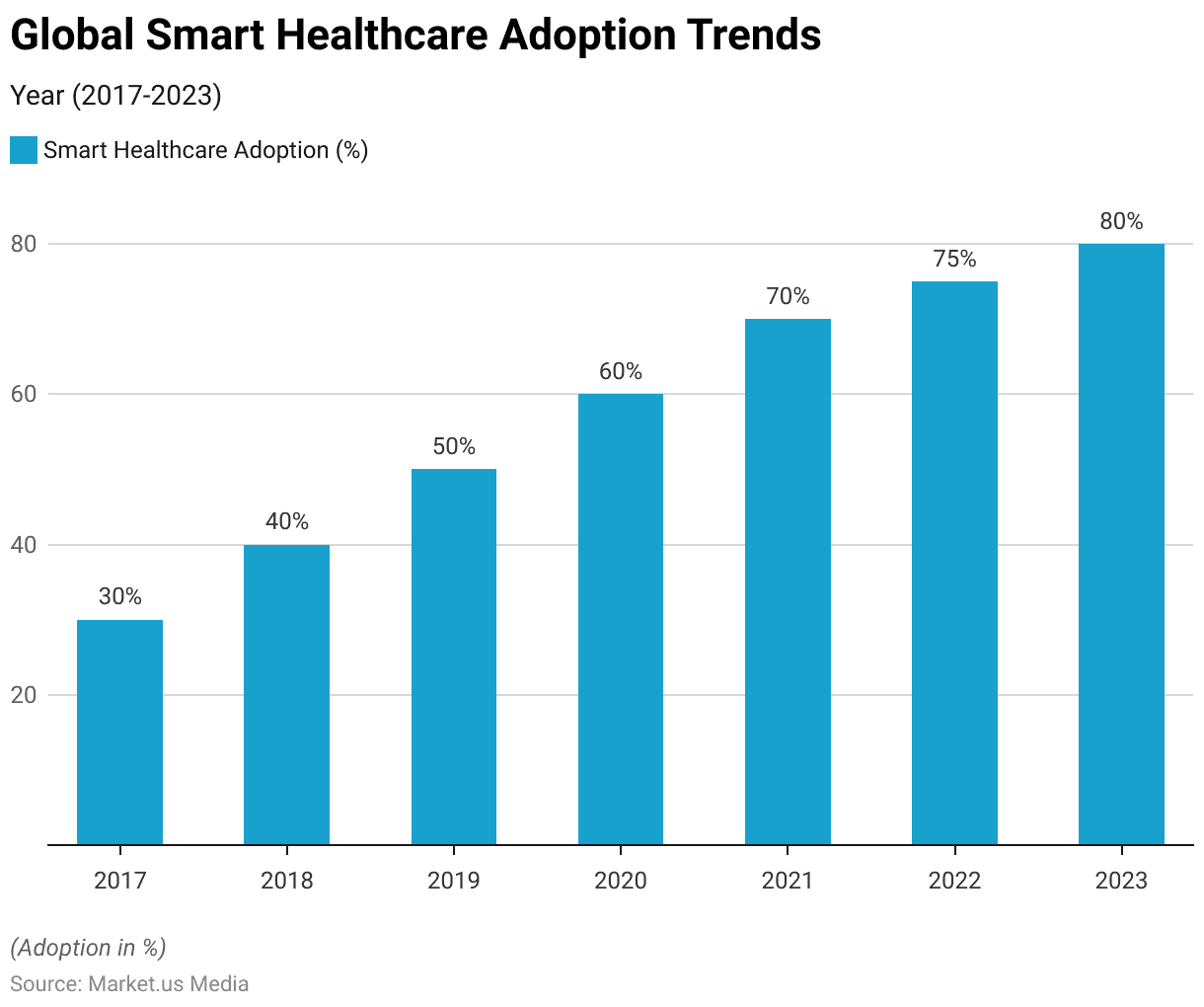
Smart Healthcare Statistics – Adoption and Implementation of Solutions
- In 2022, the smart healthcare market was valued at USD 184 billion and is expected to reach around USD 541 billion in 2032. Between 2023 and 2032, this market is estimated to register a CAGR of 15.7%.
- AI in Diagnostics: AI-based diagnostics have shown an accuracy rate of 90% in detecting certain medical conditions.
- Telemedicine Growth: Telemedicine usage has witnessed a surge of 80% globally in the last year.
- IoT in Healthcare Facilities: Over 60% of hospitals worldwide have implemented IoT devices for various healthcare applications.
- Big Data in Population Health Management: Around 85% of healthcare organizations utilize big data analytics for population health management.
- Patient Acceptance of Smart Healthcare: Approximately 70% of patients are willing to use smart healthcare solutions for better health management.
- Cybersecurity Concerns: About 75% of healthcare organizations have experienced a data breach in the past year.
- Telehealth Impact: Telehealth services have reduced hospital readmission rates by 30% in certain patient populations.
(Source: Market.us, Nature Medicine, McKinsey, Statista, HealthIT Analytics, Accenture, HIPAA Journal, American Hospital Association)

Smart Healthcare Statistics – Internet of Things (IoT) in Healthcare
- IoT adoption in healthcare is expected to reach 87% by 2025.
- Approximately 60% of healthcare organizations are already using IoT devices for monitoring and data collection.
- IoT-enabled remote patient monitoring has been shown to reduce hospital readmissions by 45%.
- The use of IoT in healthcare has resulted in a 50% reduction in patient wait times.
- IoT-based medication management has been shown to improve adherence rates by 30%.
- Healthcare facilities using IoT technology report an average cost reduction of 26% in their operations.
- IoT-powered asset tracking has reduced equipment loss and theft by 35% in hospitals.
- About 75% of healthcare executives believe that IoT will have a significant impact on patient outcomes and operational efficiency.
- IoT-powered wearables have seen a 55% increase in usage for tracking fitness and health-related metrics.
- The global healthcare IT market size is expected to be worth around USD 1,728 Billion by 2032 from USD 374 Billion in 2023, growing at a CAGR of 17% during the forecast period from 2023 to 2032.
(Source: Aruba Networks, Forbes, IBM, mHealth Intelligence, Deloitte, Healthcare IT News, Accenture, PwC)

Artificial Intelligence (AI) in Healthcare
- According to market.us, the global artificial intelligence in the healthcare market was valued at USD 9.81 billion in 2022. It is projected to reach USD 238.5 billion at a CAGR of 38.73% between 2023 to 2032.
- AI Adoption: By 2020, 33% of healthcare organizations have adopted AI technologies.
- AI in Diagnostics: AI-powered diagnostic tools have shown an accuracy rate of around 95% in detecting certain medical conditions.
- AI for Medical Imaging: AI algorithms have demonstrated 30-50% higher accuracy in detecting anomalies in medical images compared to traditional methods.
- Predictive Analytics: Healthcare providers using AI for predictive analytics have experienced a 50% reduction in hospital readmissions.
- AI-Driven Drug Discovery: AI has increased the efficiency of drug discovery processes by up to 70%.
- Personalized Treatment Plans: AI-powered data analysis has enabled personalized treatment plans, resulting in up to 60% improvement in treatment outcomes.
- Virtual Health Assistants: Over 70% of patients have expressed satisfaction with AI-powered virtual health assistants for basic healthcare inquiries.
- Disease Diagnosis Time: AI-enabled diagnosis has reduced the time required for diagnosing diseases by up to 50%.
- AI in Cancer Detection: AI algorithms have shown a detection accuracy of approximately 90% in identifying various types of cancer.
- Fraud Detection: AI-driven fraud detection systems have decreased healthcare fraud by nearly 40%.
(Source: Deloitte, Radiology, HealthITAnalytics, McKinsey, NCBI, Accenture, PwC, Forbes, Nature, AHIMA)
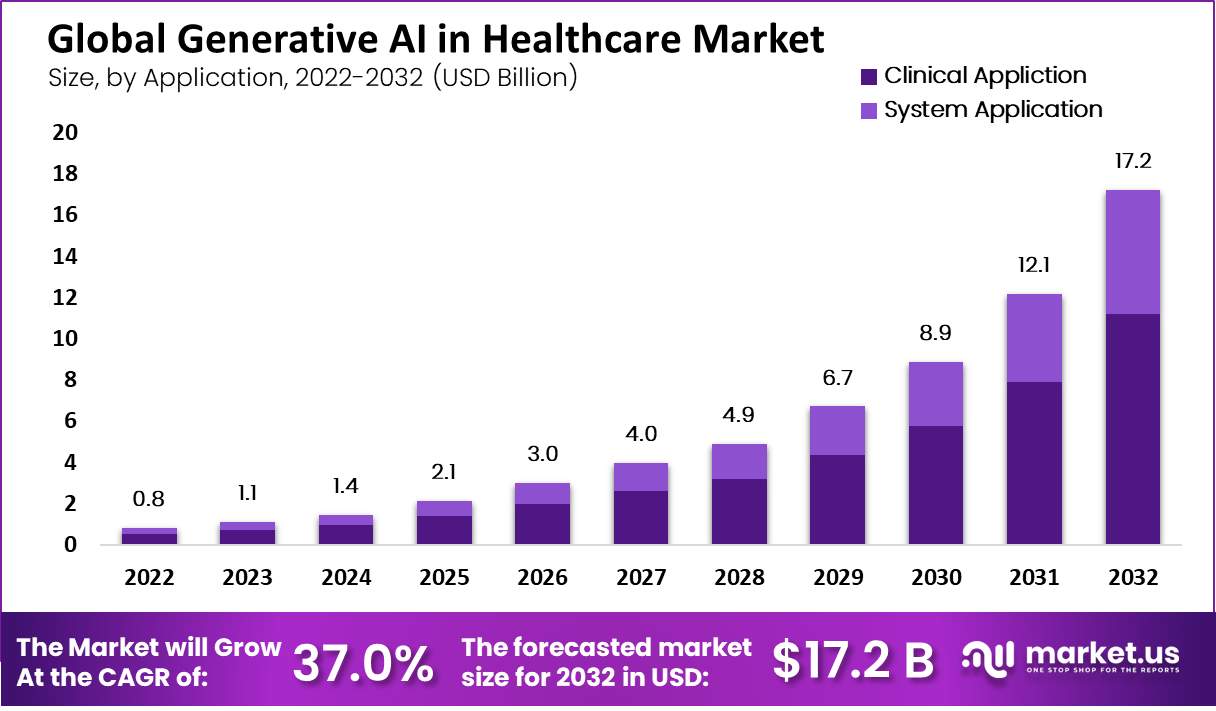
Smart Healthcare Statistics – Big Data and Analytics in Healthcare
- Over 80% of healthcare organizations believe that big data and analytics will have a significant impact on patient outcomes and operational efficiency.
- Nearly 70% of healthcare providers use predictive analytics to identify high-risk patients and potential health issues before they escalate.
- According to a survey, 60% of healthcare executives report that data analytics has led to cost savings and improved financial performance.
- Around 75% of hospitals and healthcare systems have invested in big data and analytics solutions to enhance patient care and population health management.
- The adoption of big data and analytics in healthcare has increased by 58% in the last three years, indicating a growing recognition of its potential benefits.
- Approximately 85% of healthcare providers use data analytics to monitor patient outcomes and identify opportunities for quality improvement.
- Data-driven interventions have been shown to reduce hospital readmission rates by up to 20% in certain patient populations.
- Over 90% of healthcare organizations believe that big data analytics will play a crucial role in advancing medical research and drug development.
- By leveraging predictive analytics, some healthcare providers have achieved a 30% reduction in unnecessary medical tests and procedures, leading to cost savings.
- In 2022, the global healthcare analytics market accounted for USD 29.2 billion and is expected to grow to around USD 249.3 billion in 2032. Between 2023 and 2032, this market is estimated to register the highest CAGR of 24.6%.
(Source: HealthITAnalytics, HIMSS Analytics, Deloitte, Health Data Management, HealthITAnalytics, Healthcare IT News, American Journal of Managed Care, MeriTalk, Harvard Business Review, Market.us)
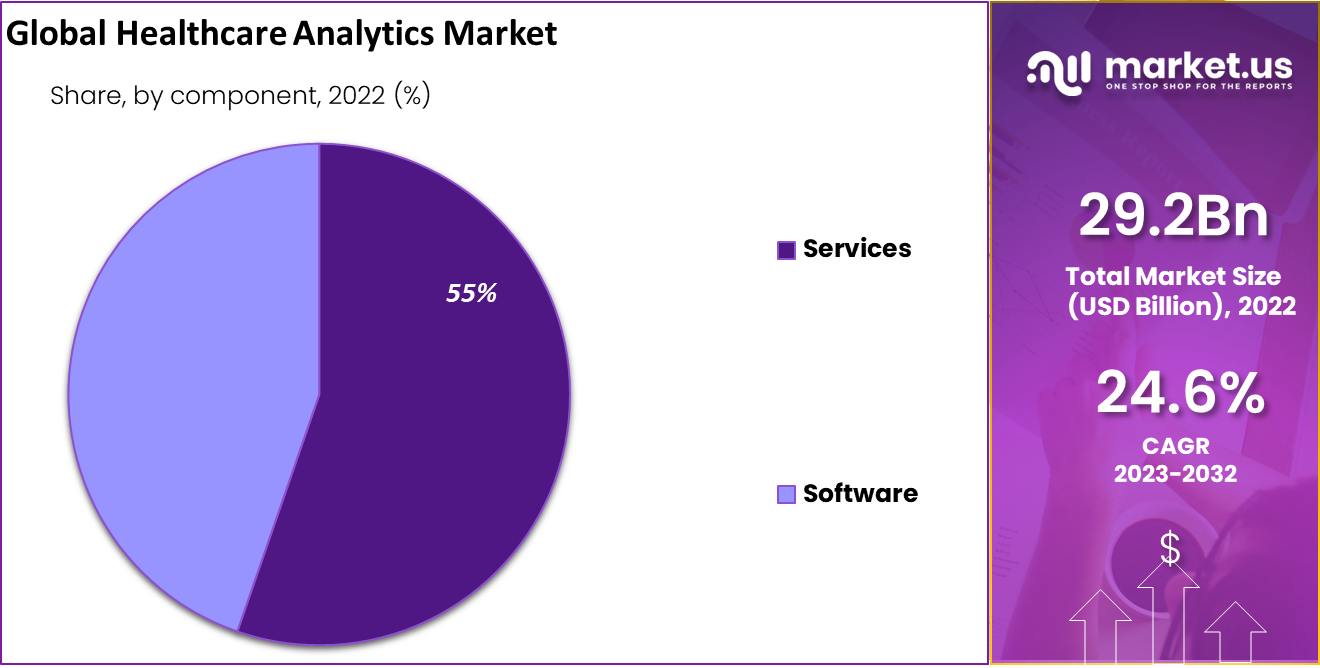
Smart Healthcare Statistics – Telemedicine and Virtual Healthcare
- Telemedicine Adoption Rate: Telemedicine usage has surged, with a significant increase in adoption. In recent years, the adoption rate has grown by over 50%.
- Patient Satisfaction: Patients are highly satisfied with telemedicine services, with approximately 85% expressing satisfaction with their virtual healthcare experience.
- Virtual Consultations Surge: Virtual consultations have seen a substantial rise, with an increase of more than 70% in the past two years.
- Healthcare Cost Savings: Telemedicine has demonstrated potential cost savings of up to 30% for both patients and healthcare providers.
- Remote Monitoring Impact: Remote patient monitoring through telemedicine has led to a 60% decrease in hospital readmissions.
- Telehealth and Chronic Conditions: Around 90% of patients with chronic conditions have reported that telehealth has helped them manage their health more effectively.
- Telemedicine and Rural Access: Telemedicine has improved healthcare access for rural communities, with 75% of rural patients having better access to medical services.
- Virtual Mental Health Services: Virtual mental health consultations have increased by 80% over the last year, highlighting the growing importance of telemedicine in mental healthcare.
- Provider Adoption: Healthcare providers have embraced telemedicine, with nearly 70% of physicians incorporating telehealth into their practice.
- Telemedicine Post-Pandemic: Post-pandemic, the use of telemedicine remains high, with 75% of patients expressing interest in continuing virtual healthcare options.
- The global telemedicine market size is expected to be worth around USD 590.9 Bn by 2032 from USD 63.5 Bn in 2022, growing at a CAGR of 25.7% during the forecast period from 2022 to 2032.
(Source: American Medical Association, Deloitte, McKinsey & Company, Health Affairs, National Institutes of Health, Teladoc Health, American Academy of Family Physicians, McKinsey & Company, Market.us)
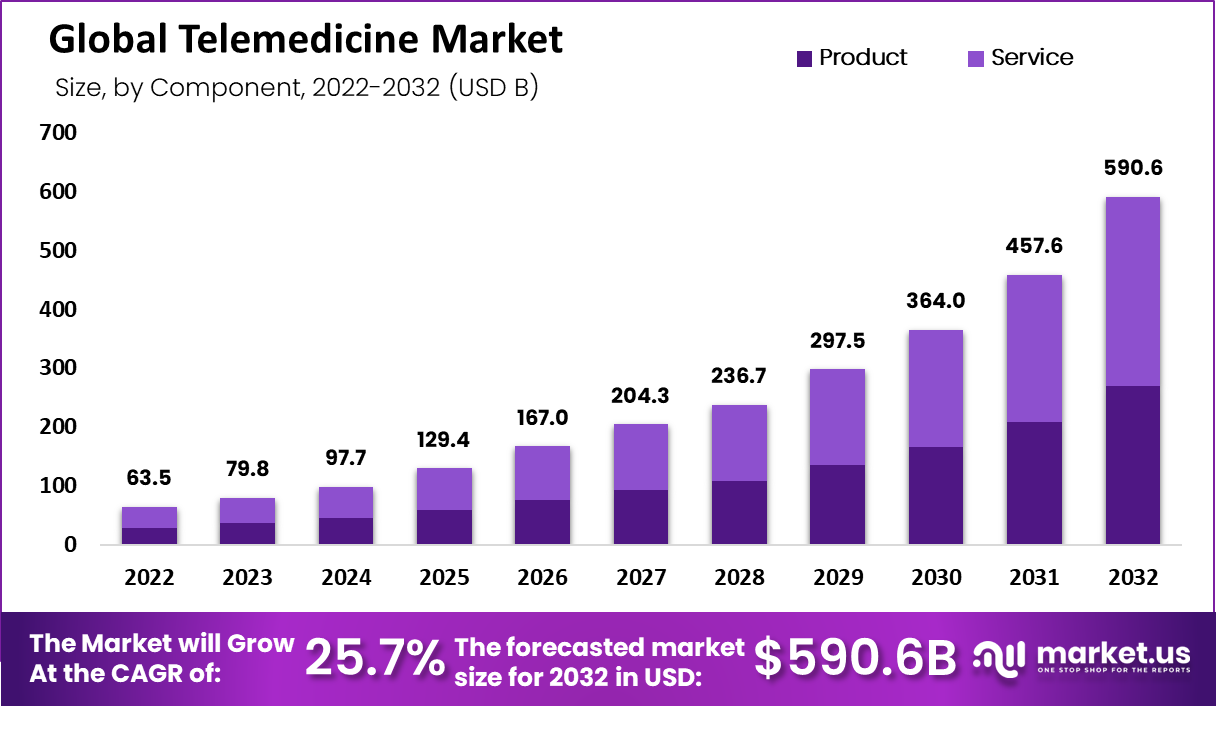
Smart Healthcare Statistics – Cybersecurity
- The cyberattacks on the healthcare sector increased by 45% globally as compared to the previous year.
- Approximately 79% of healthcare organizations experienced a significant cyberattack in past years.
- The average cost of a healthcare data breach is $7.13 million, which is higher than the global average across industries.
- The healthcare industry is projected to spend $125 billion on cybersecurity between 2020 and 2025. (Source: )
- In 2020, healthcare data breaches exposed over 30 million patient records in the United States alone.
- Medical records are valued at approximately USD 250 each on the black market, making them an attractive target for cybercriminals.
- Insider threats, including employees accessing or sharing sensitive data without authorization, account for 58% of healthcare data breaches.
- 28% of healthcare employees admitted to intentionally accessing patient data without a legitimate reason.
- 67% of healthcare organizations experienced attacks using lookalike domains.
- 34% of data breaches at these organizations occurred via authorized access or disclosure.
- 25.7% predict another Anthem-sized breach within three years (80 million+ records).
- A report by Singapore-based Cyber Risk Management (CyRiM), indicates healthcare to be one of the industries most affected by hackers; since just 2014 alone they have lost over $25 billion.
- Nearly 80 million people were exposed to the Anthem Breach.
- Globally recognized medical bodies like the Centers for Disease Control (CDC) in the US and WHO in the UN were falsely impersonated to conduct various scams during this pandemic.
- 90% of healthcare organizations face at least 1 security breach with 30% of it occurring in large hospitals.
(Source: IBM Security, Cybersecurity Ventures, Verizon’s 2021 Data Breach Investigations Report, Ponemon Institute, Accenture)
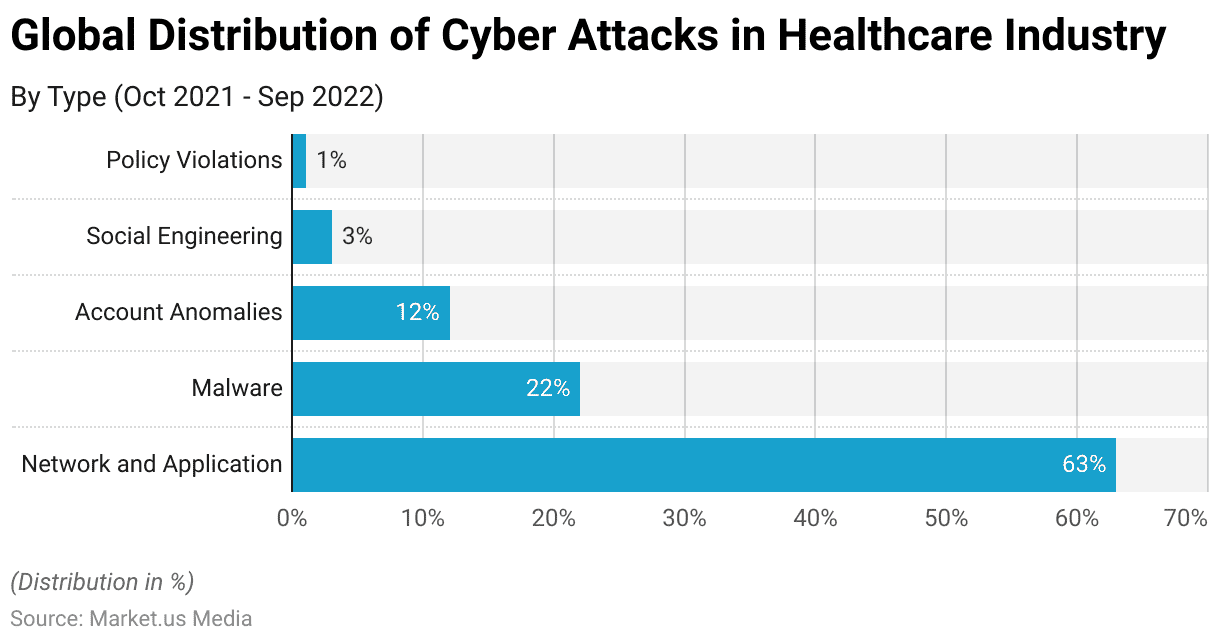
Challenges and Barriers to Smart Healthcare Implementation
- Only 38% of healthcare organizations have implemented smart healthcare solutions due to concerns about data security and privacy.
- Interoperability issues remain a significant barrier, with 65% of healthcare providers facing challenges integrating smart healthcare technologies with existing systems.
- A survey of healthcare professionals revealed that 72% struggle with the high implementation costs of smart healthcare technologies.
- Lack of skilled personnel is a hurdle, with 56% of healthcare organizations reporting difficulties in finding qualified professionals to manage smart healthcare systems.
- 40% of patients express concerns about the accuracy and reliability of smart healthcare devices, affecting their willingness to adopt these technologies.
- Limited internet connectivity in rural areas affects 30% of potential smart healthcare users, hindering their access to remote healthcare services.
- 47% of healthcare providers are hesitant to adopt smart healthcare solutions due to uncertainties surrounding regulatory compliance and policies.
- 25% of patients worry that smart healthcare technologies may compromise their personal health information.
- The complexity of smart healthcare systems results in 33% of healthcare organizations facing difficulties in training their staff to effectively use these technologies.
- 60% of healthcare providers struggle with the challenge of integrating data from various sources, limiting the full potential of smart healthcare analytics.
(Source: HIMSS Analytics, KLAS Research, McKinsey & Company, Frost & Sullivan, Deloitte, Pew Research Center, Black Book Market Research, PwC Health Research Institute, Health Management Technology, Health IT Analytics)
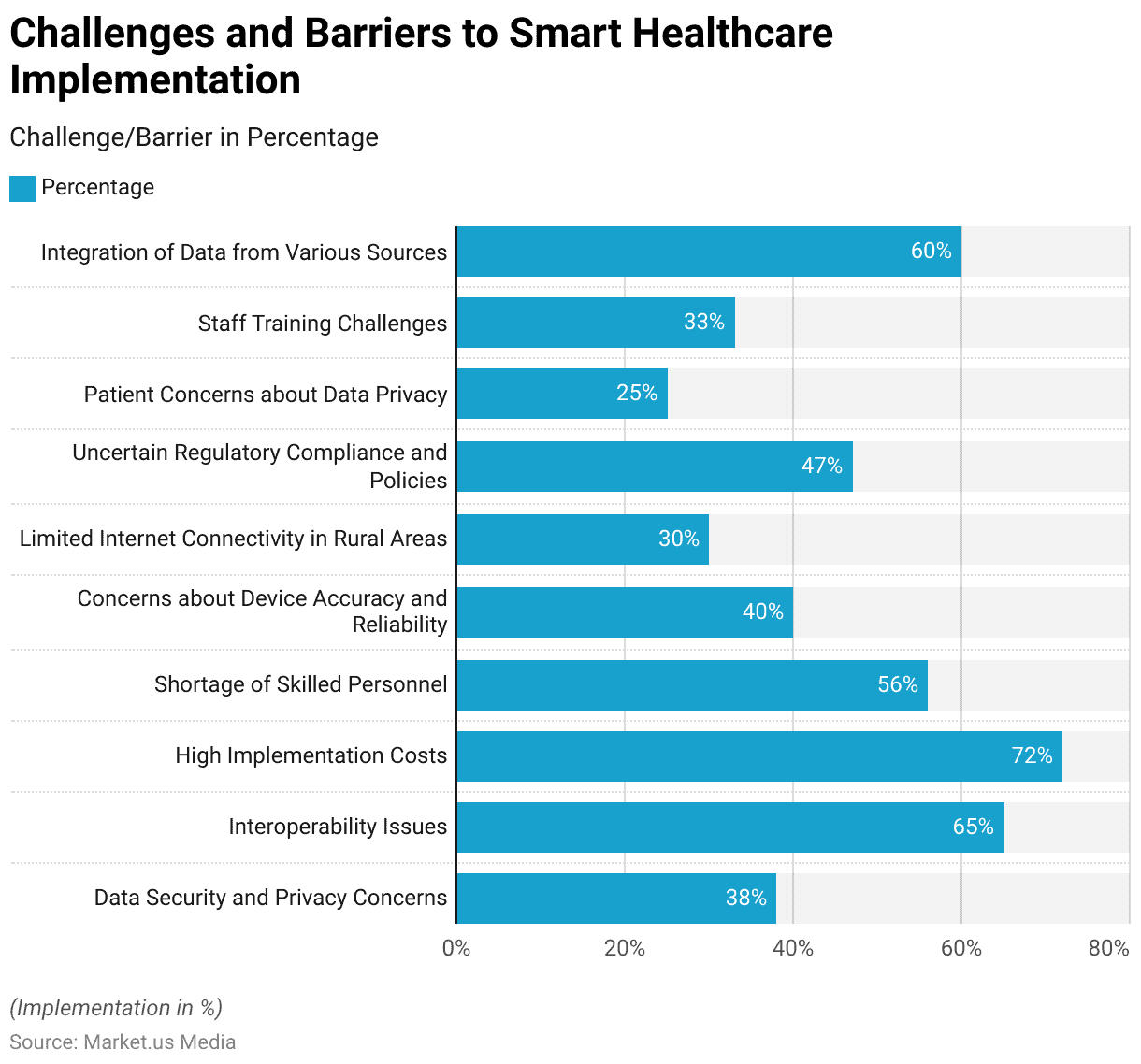
Smart Healthcare Statistics by Country
United States
- 83% of U.S. hospitals use Internet of Things (IoT) devices to monitor patients and manage medical equipment.
- The adoption of Electronic Health Records (EHRs) in the U.S. increased to 97% among non-federal acute care hospitals.
- The use of telemedicine services surged by 154% in the U.S. during the COVID-19 pandemic.
- Around 87% of physicians in the U.S. reported using smartphones for professional purposes.
- Artificial Intelligence (AI) applications in U.S. healthcare are projected to save the industry $150 billion annually by 2026.
(Source: Statista, ONC, CDC, HIMSS, Accenture)
China
- China’s digital health market is expected to reach $110 billion by 2023, driven by a surge in telemedicine and digital health services.
- Over 60% of Chinese consumers have used health-related wearable devices to track their fitness and health metrics.
- The Chinese government launched a “Healthy China 2030” initiative, aiming to promote smart healthcare and disease prevention.
- The use of AI in diagnosing diabetic retinopathy in China achieved an accuracy rate of 95.5%.
- China’s adoption of mobile health applications reached 63%, supporting remote patient monitoring and health education.
(Source: Health Europa, McKinsey & Company, WHO, Nature Medicine, Deloitte)
United Kingdom
- Approximately 94% of general practitioners in the UK now use electronic health records to manage patient data.
- The UK government invested £250 million in AI technology to improve healthcare, including personalized medicine initiatives.
- Telehealth consultations in the UK increased by 50% during the pandemic, providing access to medical services remotely.
- The National Health Service (NHS) launched a mobile app to allow patients to book appointments and access their health records digitally.
- The adoption of remote monitoring solutions in the UK resulted in a 25% decrease in hospital admissions for chronic disease management.
(Source: NHS Digital, Gov.UK, The Guardian, NHS, Imperial College London)
India
- India’s telemedicine market is projected to reach $5.5 billion by 2025, driven by increased smartphone penetration and improved internet connectivity.
- The adoption of AI-powered diagnostic tools in India resulted in a 20% improvement in early disease detection.
- The Indian government launched the National Digital Health Mission (NDHM) to provide a unique health ID to citizens and facilitate digital health services.
- Over 70% of Indian healthcare providers now use mobile health apps to deliver patient care and education.
- India’s wearable device market grew by 144% YoY, with fitness bands being the most popular category.
(Source: The Times of India, The Economic Times, The Hindu, Express Healthcare, Business Standard)
Germany
- Around 80% of German hospitals use telemedicine applications for remote patient monitoring and consultations.
- Germany’s health tech startups received €4.1 billion in funding in 2020, fueling innovation in smart healthcare.
- The adoption of AI-based clinical decision support systems in Germany resulted in a 30% reduction in medical errors.
- German consumers’ adoption of health and fitness apps increased by 35% in the last two years.
- Germany’s digital health market is projected to reach €10 billion by 2025, driven by advancements in digital health solutions.
(Source: German Medical Association, StartupBlink, HIMSS Europe, Deloitte, Roland Berger)
Recent Developments
Acquisitions and Mergers:
- The merger between Cerner Corporation and Siemens Healthineers in November 2023 to enhance digital healthcare solutions, was valued at $16.4 billion.
- Acquisition of Tempus by Google Health in December 2023 for $3.2 billion, aiming to integrate AI-driven healthcare analytics into Google’s ecosystem.
New Product Launches:
- Introduction of Fitbit Sense 2 smartwatch in January 2024, equipped with advanced health monitoring features such as continuous glucose monitoring and stress management tools.
- Launch of Philips HealthSuite Digital Platform in March 2024, offering cloud-based infrastructure for remote patient monitoring and personalized healthcare services.
Funding Rounds:
- Series C funding round for AmWell Technologies in February 2024, raising $150 million to expand telehealth services and integrate AI algorithms for diagnostics.
- Seed funding for VivaLink in April 2024, securing $10 million to develop wearable sensors for real-time health monitoring in clinical trials.
Partnerships and Collaborations:
- Collaboration between IBM Watson Health and Mayo Clinic in December 2023 to develop AI-powered clinical decision support systems for precision medicine initiatives.
- The partnership between Apple Health and Medtronic in March 2024 to integrate insulin pump data with Apple’s Health app for seamless diabetes management.
Regulatory Developments:
- FDA approval for Verily Life Sciences’ smart contact lens in February 2024, allowing continuous glucose monitoring for diabetic patients.
- European Commission’s approval of new regulations for AI-powered medical devices in March 2024, aiming to ensure safety and efficacy standards.
Investment Landscape:
- Venture capital investments in smart healthcare startups reached $9.8 billion in 2023, marking a 27% increase compared to the previous year.
- Private equity firms showed heightened interest in digital health companies, with 68% of deals involving buyouts or minority investments in 2023.
Conclusion
Smart Healthcare Statistics – Smart healthcare, fueled by advancements in technology and artificial intelligence, has revolutionized the healthcare industry, providing innovative solutions and improved patient outcomes.
Statistics indicate a significant rise in the adoption of smart healthcare systems, with a notable increase in telemedicine usage, wearable device implementation, and AI-driven diagnostics.
These advancements have not only enhanced patient care but also optimized resource allocation and reduced healthcare costs.
As smart healthcare continues to evolve, it holds tremendous potential to address the challenges of modern healthcare, making it more accessible, efficient, and patient-centric.
FAQs
Smart healthcare refers to the integration of advanced technologies and data-driven approaches into the healthcare sector to enhance patient care, improve medical processes, and optimize resource utilization. It involves the use of IoT devices, wearable sensors, artificial intelligence, big data analytics, and other technologies to provide personalized, efficient, and cost-effective healthcare solutions.
AI is used in smart healthcare to analyze large amounts of medical data, such as patient records, diagnostic images, and genetic information. AI algorithms can assist in diagnosing diseases, predicting patient outcomes, recommending treatment plans, and automating administrative tasks, leading to improved accuracy and efficiency in healthcare delivery.
Some key benefits of smart healthcare include:
– Enhanced patient outcomes and satisfaction
– Increased efficiency in healthcare processes
– Reduction in healthcare costs
– Improved patient-doctor communication
– Remote patient monitoring and management
– Early disease detection and prevention
– Predictive analytics for better treatment planning
– Integration of data for holistic patient care
Discuss your needs with our analyst
Please share your requirements with more details so our analyst can check if they can solve your problem(s)



